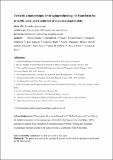Files in this item
Towards a macroscope : leveraging technology to transform the breadth, scale and resolution of macroecological data
Item metadata
| dc.contributor.author | Dornelas, Maria | |
| dc.contributor.author | Madin, Elizabeth M. P. | |
| dc.contributor.author | Bunce, Michael | |
| dc.contributor.author | DiBattista, Joseph D. | |
| dc.contributor.author | Johnson, Mark | |
| dc.contributor.author | Madin, Joshua S. | |
| dc.contributor.author | Magurran, Anne E. | |
| dc.contributor.author | McGill, Brian J. | |
| dc.contributor.author | Pettorelli, Nathalie | |
| dc.contributor.author | Pizarro, Oscar | |
| dc.contributor.author | Williams, Stefan B. | |
| dc.contributor.author | Winter, Marten | |
| dc.contributor.author | Bates, Amanda E. | |
| dc.date.accessioned | 2020-11-12T00:38:48Z | |
| dc.date.available | 2020-11-12T00:38:48Z | |
| dc.date.issued | 2019-11-15 | |
| dc.identifier | 263712802 | |
| dc.identifier | 9641dbd0-7125-40e3-808a-67940660ebf5 | |
| dc.identifier | 85075043550 | |
| dc.identifier | 000495839000001 | |
| dc.identifier.citation | Dornelas , M , Madin , E M P , Bunce , M , DiBattista , J D , Johnson , M , Madin , J S , Magurran , A E , McGill , B J , Pettorelli , N , Pizarro , O , Williams , S B , Winter , M & Bates , A E 2019 , ' Towards a macroscope : leveraging technology to transform the breadth, scale and resolution of macroecological data ' , Global Ecology and Biogeography , vol. 28 , no. 12 , pp. 1937-1948 . https://doi.org/10.1111/geb.13025 | en |
| dc.identifier.issn | 1466-822X | |
| dc.identifier.other | RIS: urn:98C2A12D7647C4C8FF0C90D09CD06197 | |
| dc.identifier.other | ORCID: /0000-0002-0036-2795/work/65345384 | |
| dc.identifier.uri | https://hdl.handle.net/10023/20955 | |
| dc.description | M.D. is grateful for support from the Templeton Foundation (grant #60501, “Putting the Extended Evolutionary Synthesis to the Test”) and from a Leverhulme Trust Fellowship. | en |
| dc.description.abstract | The problem Earth‐based observations of the biosphere are spatially biased in ways that can limit our ability to detect macroecological patterns and changes in biodiversity. To resolve this problem, we need to supplement the ad hoc data currently collected with planned biodiversity monitoring, in order to approximate global stratified random sampling of the planet. We call this all‐encompassing observational system ‘the macroscope’. The solution With a focus on the marine realm, we identify seven main biosphere observation tools that compose the macroscope: satellites, drones, camera traps, passive acoustic samplers, biologgers, environmental DNA and human observations. By deploying a nested array of these tools that fills current gaps in monitoring, we can achieve a macroscope fit for purpose and turn these existing powerful tools into more than the sum of their parts. An appeal Building a macroscope requires commitment from many fields, together with coordinated actions to attract the level of funding required for such a venture. We call on macroecologists to become advocates for the macroscope and to engage with existing global observation networks. | |
| dc.format.extent | 12 | |
| dc.format.extent | 786536 | |
| dc.language.iso | eng | |
| dc.relation.ispartof | Global Ecology and Biogeography | en |
| dc.subject | Biodiversity | en |
| dc.subject | Monitoring | en |
| dc.subject | Sampling design | en |
| dc.subject | QH301 Biology | en |
| dc.subject | 3rd-NDAS | en |
| dc.subject | SDG 14 - Life Below Water | en |
| dc.subject.lcc | QH301 | en |
| dc.title | Towards a macroscope : leveraging technology to transform the breadth, scale and resolution of macroecological data | en |
| dc.type | Journal article | en |
| dc.contributor.sponsor | John Templeton Foundation | en |
| dc.contributor.institution | University of St Andrews. School of Biology | en |
| dc.contributor.institution | University of St Andrews. Centre for Biological Diversity | en |
| dc.contributor.institution | University of St Andrews. Fish Behaviour and Biodiversity Research Group | en |
| dc.contributor.institution | University of St Andrews. Marine Alliance for Science & Technology Scotland | en |
| dc.contributor.institution | University of St Andrews. Scottish Oceans Institute | en |
| dc.contributor.institution | University of St Andrews. Sea Mammal Research Unit | en |
| dc.contributor.institution | University of St Andrews. Sound Tags Group | en |
| dc.contributor.institution | University of St Andrews. Bioacoustics group | en |
| dc.contributor.institution | University of St Andrews. Institute of Behavioural and Neural Sciences | en |
| dc.contributor.institution | University of St Andrews. St Andrews Sustainability Institute | en |
| dc.contributor.institution | University of St Andrews. Centre for Research into Ecological & Environmental Modelling | en |
| dc.identifier.doi | https://doi.org/10.1111/geb.13025 | |
| dc.description.status | Peer reviewed | en |
| dc.date.embargoedUntil | 2020-11-12 | |
| dc.identifier.grantnumber | 60501 | en |
This item appears in the following Collection(s)
Items in the St Andrews Research Repository are protected by copyright, with all rights reserved, unless otherwise indicated.

